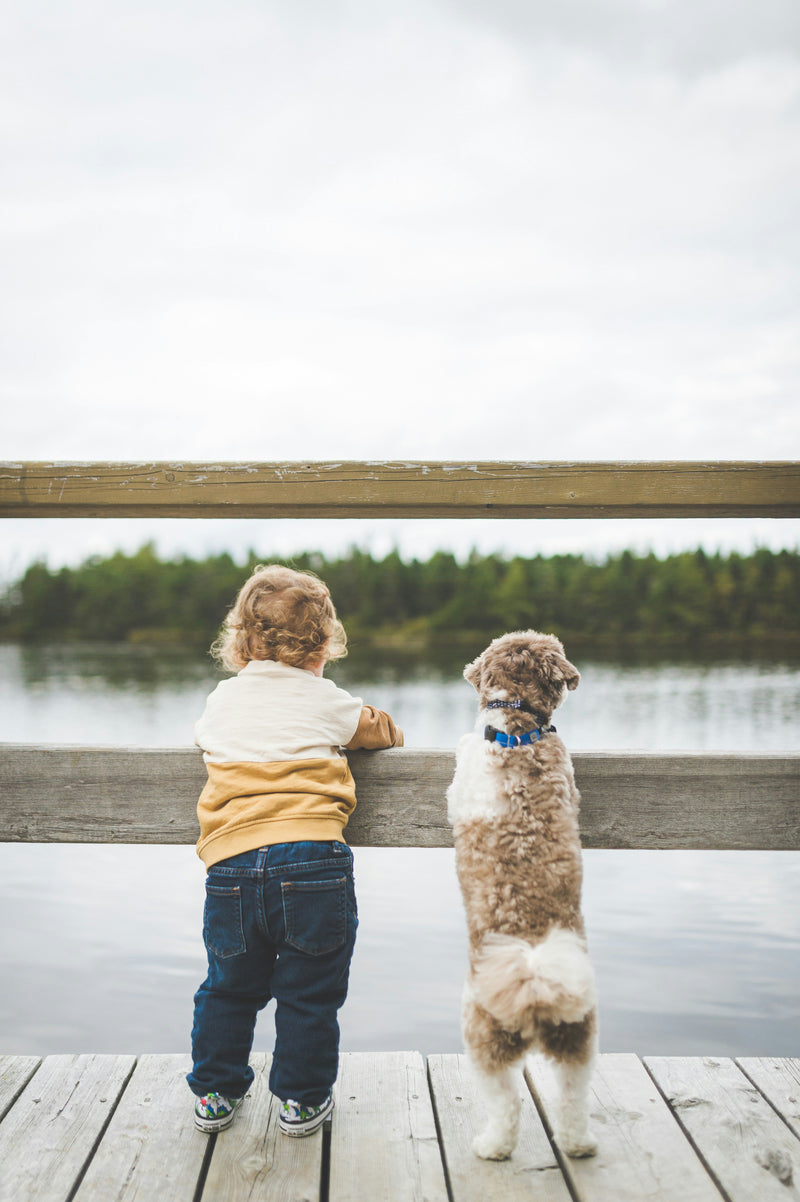
Wild Wisdom: How Our Animal Friends Become Children's Greatest Teachers 🦁🌟
Picture this: A shy five-year-old who barely speaks above a whisper suddenly finds her voice when talking to the family dog. A cautious seven-year-old who avoids playground risks enthusiastically helps care for classroom guinea pigs. A frustrated eight-year-old who struggles with patience sits quietly for an hour watching caterpillars in their garden. What's happening here isn't magic—it's the profound teaching power of our animal companions, offering lessons in confidence, curiosity, and kindness that no textbook could ever match. 🐶💫
The Animal Advantage: Why Furry Teachers Are So Effective 🎓🐾
There's something uniquely powerful about the way animals connect with children. Unlike human interactions, which can feel complex or judgmental, animals offer something beautifully simple: authentic, unconditional presence. This creates the perfect learning environment for developing essential life skills.
Research consistently shows that children who interact regularly with animals demonstrate remarkable growth in:
- Self-confidence and emotional security 💪❤️
- Natural curiosity and observational skills 🔍🧠
- Empathy and compassionate behavior toward others 🤗💕
- Stress regulation and emotional resilience 😌🧘♀️
- Social skills and communication abilities 🗣️👫
The stories in the My Furry Soulmates series capture these magical learning moments through engaging animal characters who model confidence, curiosity, and kindness in relatable ways. 📚✨
Confidence Lessons from the Animal Kingdom 🦋💪
Animals are natural confidence coaches, teaching children through example rather than instruction. Here's how different animals model confidence-building behaviors:
The Brave Little Bird: Trying New Things 🐦🌈
Watch a young bird learning to fly—it doesn't wait until it's "ready." It takes that first leap with determination and trust. Children observe this natural courage and begin to understand that trying new things is part of growing up, not something to fear.
The Persistent Squirrel: Bouncing Back from Setbacks 🐿️🔄
A squirrel doesn't give up when the bird feeder proves tricky to reach. It tries different approaches, learns from what doesn't work, and celebrates small victories. Children watching this natural problem-solving begin to see that persistence pays off.
The Confident Cat: Self-Assurance Without Arrogance 🐱👑
Cats move through the world with quiet confidence—they know their worth without needing to prove it to everyone around them. This teaches children that true confidence comes from within, not from showing off or putting others down.
The Confident Mindset Journal helps children reflect on these animal observations and apply confidence lessons to their own lives. 📔🌟
Curiosity Champions: What Animals Teach About Wonder 🧐✨
Animals are naturally curious beings, and this quality is incredibly contagious for children. Every animal interaction becomes a masterclass in observation, questioning, and discovery.
The Investigating Puppy: Questions Are Good 🐕❓
Puppies explore everything with their noses, paws, and mouths. They don't worry about looking silly or asking "too many questions." Children learn that curiosity is natural and valuable, not annoying or inappropriate.
The Observant Owl: Patience in Discovery 🦉👀
Owls teach children that sometimes the best learning happens when we sit quietly and pay attention. Not everything needs to be rushed—some discoveries require patient observation.
The Exploring Turtle: Your Own Pace Is Perfect 🐢🎯
Turtles show children that exploration doesn't have to be fast or dramatic to be meaningful. Every child can be curious in their own way, at their own speed.
The Busy Bee: Purpose in Exploration 🐝🎯
Bees demonstrate that curiosity can have purpose—they explore to learn, gather, and contribute to their community. Children begin to understand that their questions and investigations matter.
The Curiosity Mindset Journal encourages children to channel their natural wonder into deeper learning and exploration. 🔍📝
Kindness Teachers: The Gentle Lessons Animals Provide 💕🦆
Perhaps nowhere is animal wisdom more profound than in teaching kindness. Animals demonstrate compassion, care, and gentleness in ways that deeply touch children's hearts.
The Protective Mama Bear: Love in Action 🐻👨👩👧👦
Mother animals caring for their young show children what protective love looks like—fierce when necessary, gentle most of the time, always present and attentive.
The Helpful Dolphin: Community Care 🐬🤝
Dolphins are known to help injured members of their pod, teaching children that kindness means looking out for others who need support.
The Gentle Giant Elephant: Strength with Tenderness 🐘💖
Elephants use their enormous strength delicately—carefully picking up small objects or gently touching family members. Children learn that being strong doesn't mean being rough.
The Loyal Dog: Friendship Without Conditions 🐕🦺💫
Dogs demonstrate unconditional love and loyalty, showing children what it means to be a true friend—present through good times and bad, forgiving quickly, celebrating together.
The Kindness Mindset Journal helps children develop the empathy and compassion they naturally feel toward animals into kindness toward humans as well. 📔❤️
Real-World Animal Classrooms: Where Learning Happens Naturally 🌍📚
The most powerful animal teachers aren't always in zoos or nature documentaries—they're often right in children's everyday environments:
Backyard Birds: Daily Confidence Lessons 🏡🐦
Watching birds build nests, find food, and care for babies teaches persistence, resourcefulness, and parental love on a daily basis.
Neighborhood Cats: Independence with Connection 🏘️🐱
Community cats show children how to be independent while still maintaining relationships and seeking help when needed.
Classroom Pets: Responsibility and Routine 🏫🐹
Caring for classroom animals teaches children about responsibility, consistency, and the satisfaction of nurturing something smaller than themselves.
Family Pets: Emotional Intelligence Development 👨👩👧👦🐕
Living with pets provides constant opportunities to read non-verbal cues, practice empathy, and learn about different personalities and needs.
Wildlife Encounters: Respect and Wonder 🦌🌲
Even brief encounters with wild animals teach children about respect, appropriate boundaries, and the beauty of observing without interfering.
The Science Behind Animal-Assisted Learning 🧠🔬
Research continues to validate what many parents and teachers have long observed: animals are powerful learning facilitators. Studies show that children who interact with animals experience:
- Increased oxytocin (the "bonding hormone") which reduces stress and increases feelings of safety 🧬💕
- Improved focus and attention during learning activities 🎯📖
- Enhanced emotional regulation skills 😌🧘♂️
- Greater willingness to take appropriate risks 🌟💪
- Increased empathy and prosocial behavior toward humans 🤗👥
The My Furry Soulmates series harnesses these benefits through carefully crafted stories that help children process and apply animal wisdom to their own lives. 📚🧠
Practical Ways to Maximize Animal Learning 🛠️🎨
Want to help children learn more from their animal encounters? Try these approaches:
Encourage Quiet Observation 👀🤫
Teach children to spend time simply watching animals without immediately trying to interact. What do they notice about animal behavior, communication, or problem-solving?
Ask Open-Ended Questions 🤔💭
"What do you think that dog is feeling right now?" or "Why might that bird be acting that way?" encourages empathy and critical thinking.
Create Animal Care Opportunities 🥕🐰
Even small responsibilities like filling water bowls or scattering bird seed help children practice nurturing behaviors.
Read Animal Stories Together 📖🦊
Books like those in the My Furry Soulmates series help children process animal wisdom and apply it to human situations.
Use Journaling for Reflection 📝✨
The Confident Mindset Journal, Curiosity Mindset Journal, and Kindness Mindset Journal can help children reflect on what they're learning from animal interactions.
Model Respectful Animal Interaction 🙏🐾
Show children how to approach animals calmly, respect their space, and read their body language for comfort levels.
When Animals Aren't Available: Bringing Wild Wisdom Home 🏠🌟
Not every family can have pets, and that's perfectly okay! There are many ways to access animal wisdom:
Nature Documentaries with Discussion 📺🗣️
Watch animal shows together and talk about the behaviors you observe. What can we learn from how different animals solve problems or care for their families?
Zoo and Aquarium Visits 🦁🐠
Focus on observation and discussion rather than just entertainment. What animal behaviors surprise or inspire your child?
Animal Books and Stories 📚🦋
The My Furry Soulmates series provides rich animal wisdom even when live animals aren't accessible.
Wildlife Photography Exploration 📸🦅
Look at animal photography together and discuss what stories the images tell about animal behavior and relationships.
Volunteer Opportunities 🤝🐕🦺
Many animal shelters welcome families with children for appropriate volunteer activities like reading to animals or helping with basic care tasks.
The Lasting Impact: Animal Wisdom for Life 🌍💫
The lessons children learn from animals don't stay in childhood—they become foundational principles for navigating life's challenges:
- Confidence building: The courage of a bird learning to fly becomes the courage to try new things throughout life 🐦✈️
- Resilience development: The persistence of a spider rebuilding its web becomes the ability to bounce back from setbacks 🕷️🔄
- Empathy cultivation: The gentleness learned from caring for small creatures extends to caring for humans in need 🐹❤️
- Natural curiosity: The wonder of watching animals becomes lifelong learning and discovery 🔍🌟
- Authentic kindness: The unconditional love observed in animals becomes the foundation for meaningful relationships 💕👨👩👧👦
By using tools like the mindset journals and animal stories, we help children process and internalize these profound lessons during their most formative years. 📚🌱
Starting Today: Simple Ways to Invite Animal Wisdom 👣🐾
You don't need elaborate setups to help children learn from animals. Start with these simple approaches:
- Point out animal behaviors during daily walks: "Look how determined that ant is!" 🐜💪
- Create a bird-watching station outside your window 🪟🐦
- Visit local pet stores for observation opportunities 🏪🐠
- Read animal stories and discuss the lessons together 📖💭
- Use animal metaphors to help children understand their own experiences 🦋➡️👧🏽
- Encourage drawing or journaling about animal encounters using the mindset journals 🎨📝
Join Our Animal Wisdom Conversation! 💬🐾
What animal encounters have been most meaningful for the children in your life? How have you seen animals teach confidence, curiosity, or kindness? Share your stories in the comments below!
*Remember: When we help children learn from our animal friends, we're opening doorways to some of life's most important lessons. Animals teach with their whole beings—authentically, patiently, and without judgment. They show our children that confidence doesn't require perfection, curiosity doesn't require answers, an



0 comments